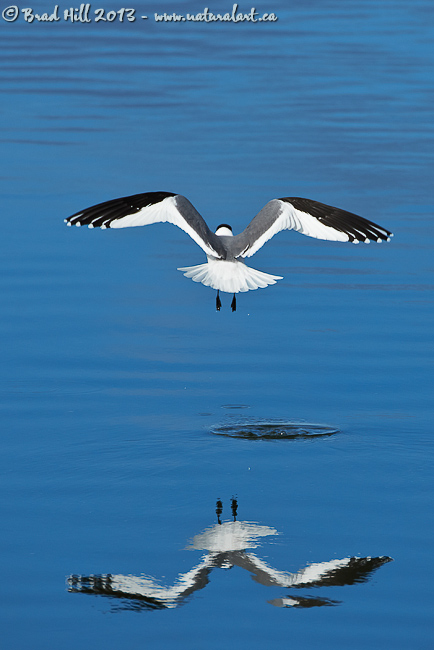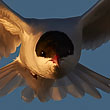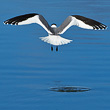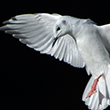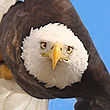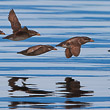Availability: Undetermined - Enquiries?
In the Field
Sabine's Gull - Time & Space. Victoria Island, Nunavut, Canada. June 28, 2013.
I'm guessing that photographing foraging gulls from behind violates someone's rules about how flight shots should be "properly" done. Which means I probably shouldn't have bothered shooting this image of a Sabine's Gull doing its best imitation of an Arctic Tern when it was grabbing some grub through "surface-seizing". Oh well...silly me - I guess ignorance is bliss, eh?
I've mentioned elsewhere (see the "In the Field" notes for this image) how unusual and distinctive the Sabine's Gull is. While this image is obviously not intended as a "documentary" shot, it does show the diagnostic (and very striking) plumage pattern on the wing of the Sabine's Gull. The dark head plumage of the Sabine's Gull is seen only during breeding season (on both males and females), but the diagnostic wing pattern shown here is seen in all plumages.
On the technical side - oops...I blew it there too - ya' caught me using "substandard" equipment again - a "measly" D600 paired with that "enthusiasts-only" AF-S 80-400mm VR lens! Just more ignorance on my part - and a little more bliss! ;-)
Behind the Camera
Sabine's Gull - Time & Space. Victoria Island, Nunavut, Canada. June 28, 2013.
Digital Capture; Compressed RAW (NEF) 14-bit format; ISO 250.
Nikon D600 paired with Nikkor AF-S 80-400mm ff4.5-5.6 VR (@ 400mm). Hand-held. VR on and in normal mode.
1/1250s @ f7.1; -0.67 stop compensation from matrix-metered exposure setting.
At the Computer
Sabine's Gull - Time & Space. Victoria Island, Nunavut, Canada. June 28, 2013.
RAW Conversion to 16-bit TIFF, including first-pass/capture sharpening using Capture One Pro version 7.
Further digital corrections on resulting 16-bit TIFF files using Adobe's Photoshop CC and Light Craft's LightZone. Photoshop adjustments included very minor colour tweaks (hue rotation and desaturation of selected colours), selective contrast adjustment, and selective sharpening for web output. Final tone tweaking performed using tonemapper/re-light tool in Lightzone.
Conservation
Sabine's Gull - Time & Space. Victoria Island, Nunavut, Canada. June 28, 2013.
Ten percent of the revenue generated by this image will be donated to Raincoast.
Species Status in Canada*: Not considered at risk in the immediate future.
The Sabine's Gull (Xema sabini) is a very unusual and highly-distinctive arctic gull that breeds only on tundra in high latitudes. This species is considered to be an aberrant gull, both physically and in its behaviour. It is only one of two gulls with a black bill with yellow tip. And, on the behavioural side, it acts in some ways more as a shorebird than a typical gull (e.g., it has a distraction display used when one is near the nest, often feeds on mudflats in a manner similar to shorebirds, etc.). And, in other ways, it acts more similarly to a tern than to other gulls (e.g., in its flight pattern, its calls, and when hovering during foraging, etc.).
The Sabine's Gull often nests in association with Arctic Terns. It is unknown whether this is done to take advantage of the protection of the nest by the tern's aggressive bahaviour (which seems unlikely as the Sabine's Gull is often equally as aggressive) or if its simply a matter of having similar habitat or food requirements.
Owing to its remote nesting locations and huge and widely disparate over-wintering areas (some over-winter off the western coast of South America, while others over-winter off the western coast of southern Africa), population sizes and population trends are unknown. Additionally, the impact of anthropogenic climate change on the breeding success and long-term health of this species is currently completely unknown.
*as determined by COSEWIC: The Committee on the Status of Endangered Wildlife in Canada













